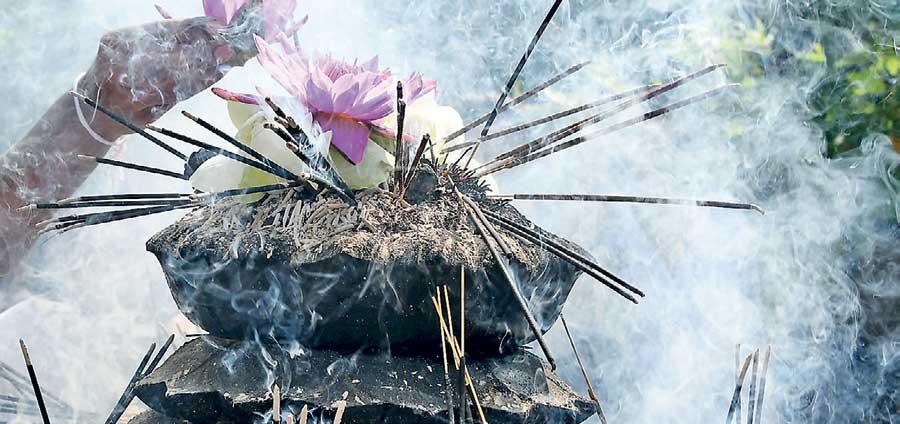Reply To:
Name - Reply Comment

If Sri Lanka’s politicians genuinely wish to preserve and foster Buddhism, then it is their bounden duty, to teach our younger generations the Dhamma
Two of the Buddha’s teachings on racism are applicable today. The first is, there’s nothing about birth or social position that makes a person good or bad. Men are good or bad exclusively in terms of their actions, and that’s how they should be judged—not by the tint of their skin. There’s no physical mark that tells you if a person is trustworthy or not. If you judge people by their appearance, you are reducing human beings—to animals.
“The deepest crux of these negative effects on the individual may be summed up as a profound loss of freedom. By accepting a belief that one does not oneself actually see as true, the mind is thereby prevented from discovering truth as it actually is. If you discern the falseness of organised belief, that through any particular belief you cannot understand reality, nor through any authority whatsoever can intelligence be awakened, then you as individuals, not as an organised group, will free yourselves from this destructive imposition.”-J Krishnamurthi
Buddhism is generally regarded as the most peaceful of world religions, it stresses the principle of ahimsa, the ‘non-injury’ of other living being. Its teachings also emphasise that violence harms the spiritual state of the perpetrator, as well as the victim. Malicious thoughts and deeds are obstacles on the path to nirvana, which is the end-point of all spiritual endeavour. Buddha stopped a looming war over water supplies with a rival clan, the Koliyas. Emperor Ashoka after converting to Buddhism, is believed to have felt repentance for the bloodshed he had caused in his earlier life.
The Muslim traders who reached the island many centuries ago, established permanent residence here. They had marital relations with the Sinhalese and the Tamils--and lived with peace and harmony. Ceylonese kings gave them honorary titles for their valuable services. Portuguese in 1505 invaded Western, Southern, and Eastern coastal belts, and harassed them cruelly at one time, forcing them to seek protection with the Kandyan Kings, who offered them State land and security.
When a government, however popular, begins to help racial or religious emotionalism merely because it is a harsh and loud-noised demand made on it, and then interferes in the management and enforcement of law and order for the advantage of its favourites or to win the applause of a crowd, however out of control it may be, disaster is certain.
“My Parents had early given me religious Impressions, and brought me through my Childhood piously in the Dissenting Way. But I was scarce 15 when, after doubting by turns of several Points as I found them disputed in the different Books I read, I began to doubt of Revelation itself. Some Books against Deism fell into my Hands; they were said to be the Substance of Sermons preached at Boyle’s Lectures. It happened that they wrought an Effect on me quite contrary to what was intended by them: For the Arguments of the Deists which were quoted to be refuted, appeared to me much Stronger than the Refutations. In short I soon became a thorough Deist”. --Benjamin Franklin, []Part I, p. 45 of autobiography]
If Sri Lanka’s politicians genuinely wish to preserve and foster Buddhism, then it is their bounden duty, to teach our younger generations the Dhamma, by Buddhist prelates who have realized the philosophical insights, so that religious freedom for all communities, could be achieved by enhancing interreligious and inter racial harmony and tolerance. They must consider introducing the subject of ‘Comparative Religion’, to all schools, whereby all would understand, the religion of the other. A deeper understanding of the fundamental philosophy of diverse religions would ensure, from an early age, that no religion or race is above the other. They will not feel threatened by the religion of the other; will certainly have a much deeper sympathy of human viewpoints and practices, and therefore be more liberal of each other.
This would certainly guide them towards our ultimate dream of a peaceful nation for all. However, it is unlikely that our politicians would take up such a challenge, a peaceful harmonious society is not what they anticipate; for they know that religious and racial tensions in society can be easily manipulated for their advantage.
Man and Life…
One has to appreciate life, the emptiness of our fantasy labeling as Sinhalese, Tamil or Muslim, that originated from a social conditioning shaped by our inherited pedigree than some deep-rooted hereditary fact of sharing a common and distinctive culture, religion, language. Our parents conditioned our ideals; so we follow Sinhalese, Tamil or Muslim traditions and fasten labels or social tags, label of caste, creed, religion and ethnicity.
Conflict in 1915 “… lower classes of Sinhalese, the farmers, artisans and the unemployed against the Moslems…”
The village population in 1915, constituted 85 percent of illiterate lower classes of Sinhala, Muslim and Tamil community compared to today’s social standards and high literacy rate. When the infamous Sinhala-Muslim riots broke out between the two races 104 years ago, a report on the occurrence was prepared by C P Dias, Head-master of Wesley College and a senior member of Colombo Municipality, at the request of Sir Ponnambalam Ramanathan, the member representing the educated Ceylonese in the Legislative Council [LG] Extracts from the report…,
“…the disturbances appear to have been a sudden outburst of feelings of resentment on the part of lower classes of Sinhalese, the farmers, artisans and the unemployed against the Moslems…”.The riots blew up when a group of Moors in Gampola attacked a Buddhist pageant with stones on a Vesak day; the news soon spread across the island. The Sinhala hooligans in turn retaliated; they harassed the Muslims in many areas. Records say, boutiques and shops destroyed and some 20 mosques were attacked, a few were killed and many injured. In some areas Christian churches were burnt down too. It all happened at a time when the British rulers’ suspicions were aroused by a new up-and-coming class of young entrepreneurs who began a temperance movement. It sparked off by legislation directed at elevating government revenue by opening new arrack taverns in all parts; the colonial rulers kept an eye on the influential.
When the Legislative Council assembled for the first time after the riots under the chairmanship of Sir Robert Chalmers, Governor, on August 6, 1915, the governor addressing the members stated,“…Ceylon has suffered a great calamity…one section of His Majesty’s subjects has attacked another section. The assailants were Buddhists Sinhalese; the victims were peaceable Muslims… the attack began at Kandy on the night of 28th May, the nativity of Gautama the Buddha; like wildfire it spread …to Rambukkana, and thence through Colombo down the coast to Matara …what has befallen the Muslims at Sinhalese hands in the five provinces is that their property has been looted , their houses and shops have been wrecked, their Mosques have been desecrated and destroyed , and they have themselves been wounded, outraged and murdered …”
-Hansard: 6/8/1915 fol. 330

This could have been settled easily by the local leaders then and there. The law enforcement authorities should have taken steps to disallow the trouble creators who first assembled near Police station to make hate speeches inciting the “lower classes of Sinhalese, the artisans and the unemployed?”, yet exists after a laps of 100 years. The Catholic and Buddhist clergy have acted with lot of restrain; there had been no inflammatory speeches calling for the destruction of community unlike in previous occassions.
The communal riots of 1983 was a blot on the Sinhala race. That humiliation is cast on them, despite the virtuousness of the vast majority, some even risked their lives to save Tamil brethren under attack. The real culprits of 1983 were the power drunk political leaders who preferred violence as a weapon of reconciliation. But since then there was never a mass retaliation. A shocked and grieved people suffered the bereavements with resignation, a true hallmark of a people nurtured in a Buddhist cultural tradition of kindness, friendship, softness, and equanimity for over twenty six centuries.
As usual a Government spokesman says they suspect of a ‘hidden hand’; but people know of quite a ‘few hidden hands’ working behind the scenes on both sides of the divide. The state authorities up to now have been slow to act against mischief makers and their political leaders who pet and pamper terrorists and violators of peace.
“... organized religions have nothing to do with the sayings of the great teachers. The teachers have said do not kill, love your neighbour, but religions of vested interest encourage and support the slaughter of humanity. By encouraging Race and nationalism, supporting a special class, with all its organized belief, religion participates in the killing of man. Religions throughout the world not only exploit through fear, but also separate man from man. Such organized religions cannot in any way aid man in the realization of truth.”-J Krishnamurthi
Writer can be contacted at -
[email protected]